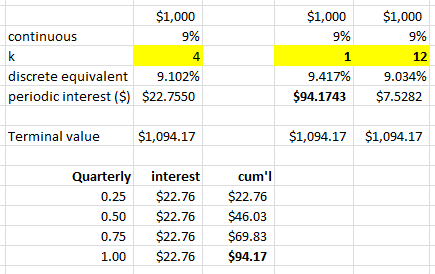Steve Jobs
Active Member
Assume the following:
An asset is quoted at 12% annually with continuous rate.
Interest is paid quarterly.
Is this correct for equivalent rate with monthly compounding?
r = 12 * [ e^(.12/12)) - 1] = 12.06%
Does it matter whether interest is paid quarterly, monthly or annually? What about doing the reverse convert from continuous to discrete?
An asset is quoted at 12% annually with continuous rate.
Interest is paid quarterly.
Is this correct for equivalent rate with monthly compounding?
r = 12 * [ e^(.12/12)) - 1] = 12.06%
Does it matter whether interest is paid quarterly, monthly or annually? What about doing the reverse convert from continuous to discrete?

